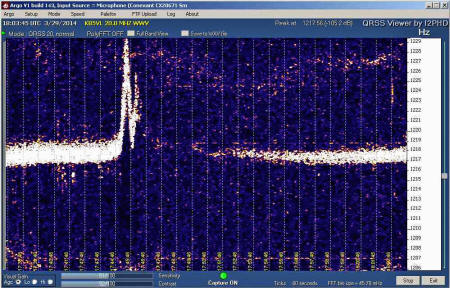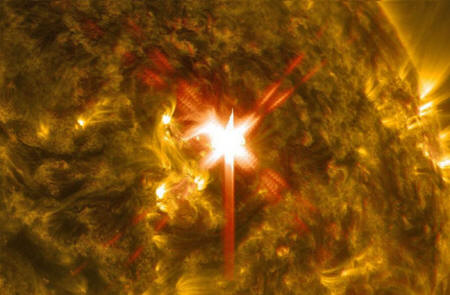|
March 31, 2014
The solar flare as observed by NASA's Solar Dynamics Observatory in extreme ultraviolet light. NASA/SDO
On Saturday, the sun erupted with an X-class solar flare, blasting Earth with powerful electromagnetic radiation.
Although we couldn't directly feel its effects on the ground, the impact of this event was measured as a dramatic radio blackout for several minutes, highlighting the fact that the sun isn't quite done with solar maximum yet.
The X1.0 flare erupted at 1:48 p.m. ET on March 29 and an armada of solar telescopes captured the event in all its glory. A solar flare occurs when highly-stressed magnetic field lines are forced together over regions of intense magnetic activity, descriptively known as "active regions."
These regions are often associated with sunspot clusters - this is why astronomers keep count of sunspots in an effort to record solar activity.
Although we are well protected from the worst effects of radiation from solar flares, ionizing X-ray and extreme ultraviolet radiation can have a disruptive impact on unshielded satellite electronics and can even give unprotected astronauts an increased radiation dose.
Our atmosphere is a thick shield that protects our biology from the sun's worst solar flares, but that's not to say that they can't impact our lives.
As reported by Spaceweather (below insert), the X1 flare, which was triggered above active region (AR) 2017, bathed our upper atmosphere in ultraviolet radiation, causing global ionization.
The aptly-named ionosphere is used for communications where radio waves are bounced around the globe.
This extensive ionization event caused the propagation of radio waves to wildly fluctuate, eventually blocking them all together. The blast was so powerful that the impulsive electrical currents generated in the ionosphere caused vast waves to ripple through our planet's magnetic field.
Radio engineer Stan Nelson located in Roswell, New Mexico, was monitoring the National Institute of Standards and Technology (NIST) WWV radio transmission (which transmits time and frequency information worldwide 24/7) during the flare and watched the signal oscillate wildly before being blocked all together.
The flare also generated its own radio signal; as the flare's shock wave blasted through the sun's corona (its atmosphere), an intense radio signal was generated and was recorded as powerful shortwave radio static.
The sun is currently experiencing the wane of solar maximum, the peak of its approximate 11-year solar cycle. Solar Cycle 24 has been a "below average" cycle exhibiting lower levels of magnetic activity - but as Saturday's flare proves, it's still capable of generating some impressive explosive displays.
Related Report:
|


